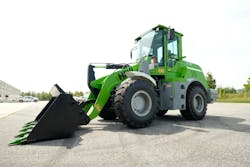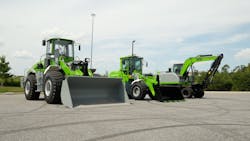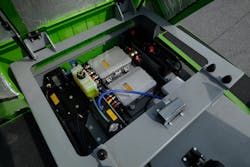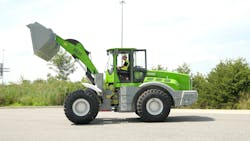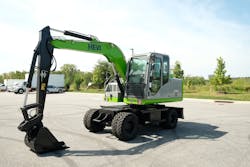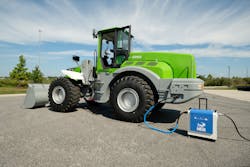Purpose-Built Design Benefits Electric Construction Equipment
The U.S. heavy equipment industry is dominated by the use of diesel. HEVI, a developer of all-electric machines, wants to change this by offering clean and sustainable alternatives to the heavy machinery space.
“Any organization looking to be a little cleaner about their work has no option today,” said Raymond Wang, CEO of HEVI, in an interview with Power & Motion. “We wanted to change that.”
In 2022, the company launched its first product line of all-electric heavy equipment which includes two front loaders (aka wheel loaders) and one excavator ranging in size from about 12,000 to 40,000 lbs. “These are the large-scale products ready for the job site to move some material and get some work done,” he said.
Wang noted the company is a subsidiary of Greenland Technologies whose core business is the manufacture of drivetrains and transmissions for various types of machines including forklifts, front loaders and excavators. “So, we took that know-how to try to electrify a space that no one else was touching – construction [and other] heavy equipment.
“At any given point in time, in the U.S., we have about 1.2 million machines operating, and each machine will burn about 10 gallons of diesel per hour of use,” explained Wang. “That is equivalent to about 200 lbs. of CO2 [carbon dioxide] burned per machine per hour…[creating] a major dent in the carbon emissions pie for our country. So, we want to try to convert as many as we can from diesel to a cleaner source.”
READ MORE: Construction Equipment Digs Deeper into Electrification
Why a Ground-Up Design is Beneficial
Although there are many heavy equipment manufacturers developing electric-powered construction equipment, much of it is still in the prototype stage. The few machines which are available on the market are in the compact size range and availability is still limited.
HEVI, however, has developed larger machines to help suit a range of application needs. And unlike some manufacturers, the company’s equipment is purpose-built for electrification and the needs of the applications in which it will be used. “These are not retrofits in any way, shape or form,” said Wang. “These are built from the ground up, designed entirely for the application.”
He said a lot of the electric vehicles in the market currently are designed for road applications where aerodynamics plays an important role. In those vehicles, the batteries are embedded in the chassis to keep a low profile and still have space for passengers. “But for heavy equipment, it’s a completely different application. Those skateboard battery systems don’t apply, they’re not good fits.”
At any job site, the bottom of a machine is likely to get bumped and dented while maneuvering over rough terrain, he explained, so you don’t want the power source located at the bottom of that piece of equipment.
Instead, HEVI places the batteries at the back of its machines. “The entire backside of our front loaders – everything behind the cab – it’s all batteries,” said Wang.
He explained that all of HEVI’s equipment is designed to operate for 9 hours on a single charge. To achieve that, a lot of battery power is required – typically batteries which are over 2 tons in size. For instance, the company’s larger loader uses a 282 kW, 660V battery.
Despite the large size of the battery, Wang said machine weight was actually reduced. “Because it’s not a retrofit, all of the motors and other system components related to an internal combustion engine were removed. It actually ends up being lighter…we had to add further ballasts to the back to make sure [the front loader] can handle the load without any risk of tipping over.”
In HEVI’s machines, the engine is completely replaced by the battery and electric motors. According to Wang, removal of the engine and its various accessory components, such as the oil tank, belts and spark plugs provides a lot of opportunity to enjoy the benefits of electric because maintenance costs are significantly reduced. “A lot of your standard routine maintenance – replacing spark plugs, changing the oil, replacing the belt – all of that is eliminated,” he said.
Besides keeping the electric motors clean, the only other maintenance necessary is keeping coolant topped off for the alternator system as well as following a standard lubrication routine for the hydraulics system.
READ MORE: The Impacts of Electrification on Fluid Power Systems
Hydraulics Benefit Ease of Use and Market Uptake
When developing its machines, HEVI wanted to make the move to electric an easy one for customers. “To get people to try new technology, we had to make sure we proceeded by baby steps,” said Wang.
In its machines, HEVI uses hydraulics to power digging and lifting functions. This helps to ensure familiarity for operators as well as performance similar to that of other equipment in the market. “Someone that’s been driving loaders or excavators all their life can get behind the wheel of [our machines] and be comfortable in 5 seconds,” he said.
The company chose to use standard, industry recognized hydraulic lines to not only ease operation but also maintenance. If someone were to work on the hydraulics system of a comparable diesel machine, he or she would be able to just as easily work with the hydraulics on HEVI’s equipment.
Wang said a major aspect of importance for HEVI’s electric machines is that they can be maintained by the owner. “We actually promote the right to repair for our equipment,” he said. “What that means is anyone that is an owner of our equipment, if they wanted to be able to replace the hydraulic lines themselves or do any type of maintenance they don’t have to work with a dealer in our network or use proprietary [technology].”
He explained that customers can call HEVI to get the information, and components if desired, necessary to perform the required maintenance. The company is also establishing a network of authorized service providers for those customers who may want such an option.
“We want to empower our clients to be able to repair [the equipment]. And the way that we can enforce that is by using as many standardized parts as we could throughout the machinery, including our hydraulic lines,” said Wang.
Multi-Motor Configuration Ensures Efficiency
The HEVI electric construction equipment uses seven primary electric motors. Only those motors required for specific tasks are used, keeping power expenditure low.
Wang explained that instead of having one major power source for all machine functions, the company separated that out into individual components based off their application in the machine. This multi-motor design helps to drive the efficiency of HEVI’s equipment.
Construction equipment and other heavy machines will have different working scenarios throughout the day – sometimes they are doing heavy work, other times they are sitting and waiting. Creating a multi-motor system ensures the needs of all those working scenarios can be met efficiently.
The system works by activating certain electric motors based on what the machine needs to be doing at the time. Those motors not being used are not running and therefore not drawing power from the batteries, ensuring efficiency and extended life.
Why Machine Owners Have Mixed Feelings on Quiet Operation
A key benefit of electric machines is their quieter operation. But Raymond Wang, CEO of HEVI, says there is still some debate about this. While collecting feedback from customers, he said there are differing opinions about whether machine noise is desired on a work site or not.
Many clients who have one to three pieces of equipment on their site want more noise with the machinery for safety reasons; they feel it provides an extra level of security being able to hear a machine coming.
But other customer sites, particularly those running multiple pieces of equipment during a shift, or running machines indoors, want less noise. If every machine is making noise when it backs up and moves forward, workers may become desensitized and thus susceptible to safety issues.
“It’s really based off need, so what we’re leaning more towards is customized options to be able to provide the right sound,” said Wang.
Wang provided an example from a customer demo in which a machine was left running yet lost very little battery power. “Being electric, our machinery is mouse quiet, which is drastically different from diesel equipment today,” he said.
After running the machine for some time, an operator got out of it and left for the day without realizing the machine was still on because it was so quiet. He came back hours later, realized the machine was running but when he stepped inside the operator cab to turn it off, he saw the battery charge had dropped by less than 1% in the 4 hours he was gone.
“He was amazed at the longevity of it,” said Wang. “While [the machine] is just sitting there, it’s not running every motor constantly. For efficiency purposes, it’s only running what it takes to be in that state.”
Demand is Growing for Electric Machines
The electric machines from HEVI are suited for applications where the equipment is not leaving the job site or will have access to power, such as waste management, agriculture, landscaping, urban construction, or public works yards. Demand for the company’s machines has been extremely high said Wang.
He said the company is the first to offer electric heavy equipment, categorized as over 10,000 lbs., in the U.S. and because of that, the company works more as educators than manufacturers at this stage due to diesel being the dominant power source for over a century. “The only thing that came before was steam power, so it’s going to take a lot to get people to try it out,” he said. “But that’s exactly what we’re doing. Our whole inventory right now is dedicated to demos.”
HEVI will bring its machines to a work site and let potential customers use them for a few days so they can see firsthand how they work. “To get them comfortable, they have to be in the seat behind the wheel. And that's exactly what we're doing,” said Wang. “And we're seeing a ton of demand.
“That will translate over because people can actually see they can do their work cleaner, can do it in a more sustainable manner for the future. This is feasible. This is technology that exists today. And that's exactly the stage that we're in.”
READ MORE: Decarbonization of Construction Equipment can aid Climate Goals
Because these electric machines are a business asset, the potential return on investment (ROI) they can provide is what initially draws customers to them. “From an ROI standpoint, we’re extremely cost advantageous,” said Wang.
The HEVI machines are priced the same as a comparable diesel, eliminating the sticker shock sometimes associated with electric vehicles. This is further benefited by the fact the company sells directly to customers instead of through dealers, enabling them to be upfront about costs and other machine aspects.
In addition, the reduced maintenance and fuel costs benefit the machine’s ROI. Recharging can take place on site, and electricity costs are much lower than diesel. Wang said in New Jersey where HEVI is headquartered, electricity is about 11 cents per kW hour, equating to about $4-6 per hour of operation. Meanwhile, diesel is about $4 per gal. and the typical machine burns 10 gal. per hour, leading to $40 per hour of operation. “Major savings [can be realized] just on a single shift in the first year,” he said. “And that gets better as the diesel [machine] becomes less efficient.
“That's how we turn heads to begin with. And then we're able to talk about the sustainability impacts, such as that piece of electric equipment offsetting 400 tons of CO2 per year on a single shift. That's the equivalent of replacing about six to eight transit buses, or over 80 passenger cars – major impact to a company's environmental goals,” he concluded.
About the Author
Sara Jensen
Executive Editor, Power & Motion
Sara Jensen is executive editor of Power & Motion, directing expanded coverage into the modern fluid power space, as well as mechatronic and smart technologies. She has over 15 years of publishing experience. Prior to Power & Motion she spent 11 years with a trade publication for engineers of heavy-duty equipment, the last 3 of which were as the editor and brand lead. Over the course of her time in the B2B industry, Sara has gained an extensive knowledge of various heavy-duty equipment industries — including construction, agriculture, mining and on-road trucks —along with the systems and market trends which impact them such as fluid power and electronic motion control technologies.
You can follow Sara and Power & Motion via the following social media handles:
X (formerly Twitter): @TechnlgyEditor and @PowerMotionTech
LinkedIn: @SaraJensen and @Power&Motion
Facebook: @PowerMotionTech
